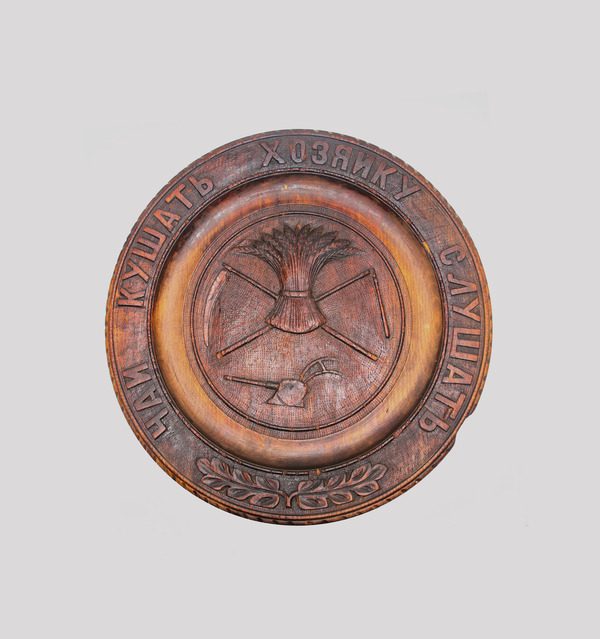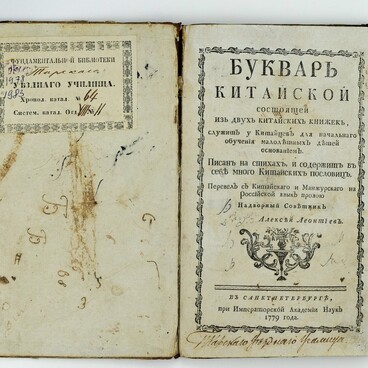In the late 19th — early 20th century, craftsmen who made dishes and other handicraft everyday objects began to turn to traditional motifs and materials. For example, they started to create wooden hanging and presentation plates and dishes, decorating them with ornaments and inscriptions — proverbs and sayings.
A bas-relief image of a sheaf with a scythe and a flail is carved at the bottom of the displayed dish. Under the composition, a plow is depicted.
Along the edge, decorated with an inner and outer rim, the text of the proverb is carved: “Have tea and listen to the mistress.” Omsk Museum of History and Regional Studies houses such decorative plates with Russian proverbs “The host is glad to share all that their house is rich with”, “The house is beautiful not by its appearance but by its hosts' pies.” They were brought to Omsk by migrants from Central Russia.
According to tradition, these dishes were used to serve bread and salt (a symbol of hospitality). This is how the welcome guests were greeted, as well as the bride and groom after the wedding.
The souvenir plate was brought to the museum by a motorman Mikhail Mikhelson. He purchased it at the First Western Siberian Exhibition for Agriculture, Forestry and Trade and Industry held in Omsk from June 15 till August 15, 1911.
The exhibition was a great event in the life of the city. There were about three thousand participants from St. Petersburg, Moscow, Odessa, Tula, the cities of the Volga region, and the Urals on the vast territory of modern Park Yunnatov. There were also company representatives from Germany, Austria-Hungary, England, Denmark, and the USA.
A road to the exhibition area was specially built. In May 1911, a telephone and water supply were installed. It was decided to electrify the exhibition: a small power station was built by foreign firms.
A lot of flowers, trees, and shrubs were planted on the territory. At the center of the exhibition, a fountain was built. The contracts with musicians and actors from the capital were signed to organize the entertainment program. There was also a concert hall, a movie theater, and music venues at the exhibition.
The pavilions were of different architectural styles, mostly Art Nouveau. The main entrance to the exhibition was decorated in “Russian style, ” in the form of the Kremlin with high towers, and the scientific pavilion — in “Egyptian style, ” with obelisks, pylons, and sphinxes. The exhibition was a great success, almost 250 thousand people visited it.
A bas-relief image of a sheaf with a scythe and a flail is carved at the bottom of the displayed dish. Under the composition, a plow is depicted.
Along the edge, decorated with an inner and outer rim, the text of the proverb is carved: “Have tea and listen to the mistress.” Omsk Museum of History and Regional Studies houses such decorative plates with Russian proverbs “The host is glad to share all that their house is rich with”, “The house is beautiful not by its appearance but by its hosts' pies.” They were brought to Omsk by migrants from Central Russia.
According to tradition, these dishes were used to serve bread and salt (a symbol of hospitality). This is how the welcome guests were greeted, as well as the bride and groom after the wedding.
The souvenir plate was brought to the museum by a motorman Mikhail Mikhelson. He purchased it at the First Western Siberian Exhibition for Agriculture, Forestry and Trade and Industry held in Omsk from June 15 till August 15, 1911.
The exhibition was a great event in the life of the city. There were about three thousand participants from St. Petersburg, Moscow, Odessa, Tula, the cities of the Volga region, and the Urals on the vast territory of modern Park Yunnatov. There were also company representatives from Germany, Austria-Hungary, England, Denmark, and the USA.
A road to the exhibition area was specially built. In May 1911, a telephone and water supply were installed. It was decided to electrify the exhibition: a small power station was built by foreign firms.
A lot of flowers, trees, and shrubs were planted on the territory. At the center of the exhibition, a fountain was built. The contracts with musicians and actors from the capital were signed to organize the entertainment program. There was also a concert hall, a movie theater, and music venues at the exhibition.
The pavilions were of different architectural styles, mostly Art Nouveau. The main entrance to the exhibition was decorated in “Russian style, ” in the form of the Kremlin with high towers, and the scientific pavilion — in “Egyptian style, ” with obelisks, pylons, and sphinxes. The exhibition was a great success, almost 250 thousand people visited it.



